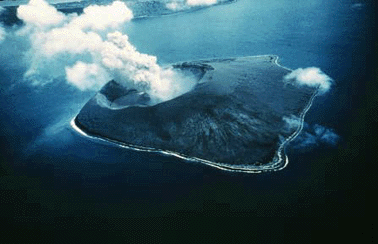
Krakatau erupted in 1883, in one of the largest eruptions in recent time. Krakatau is an island volcano along the Indonesian arc, between the much larger islands of Sumatra and Java (each of which has many volcanoes also along the arc).
There is a very fine book about the Krakatau eruption by Tom Simkin and Richard Fiske (Simkin, T., and Fiske, R.S., Krakatau 1883: The volcanic eruption and its effects: Smithsonian Institution Press: Washington, D.C., 464 p.), so if you really want to know about the eruption you should go to the nearest bookstore or library to find that.
Here are some highlights from their summary of effects:
-
The explosions were heard on Rodriguez Island, 4653 km distant across the Indian Ocean, and over 1/13th of the earth’s surface.
-
Ash fell on Singapore 840 km to the north, Cocos (Keeling) Island 1155 km to the SW, and ships as far as 6076 km west-northwest. Darkness covered the Sunda Straits from 11 a.m. on the 27th until dawn the next day.
-
Giant waves reached heights of 40 m above sea level, devastating everything in their path and hurling ashore coral blocks weighing as much as 600 tons.
-
At least 36,417 people were killed, most by the giant sea waves, and 165 coastal villages were destroyed.
-
When the eruption ended only 1/3 of Krakatau, formerly 5×9 km, remained above sea level, and new islands of steaming pumice and ash lay to the north where the sea had been 36 m deep.
-
Every recording barograph in the world documented the passage of the atmospheric pressure wave, some as many as 7 times as the wave bounced back and forth between the eruption site and its antipodes for 5 days after the explosion.
-
Tide gauges also recorded the sea wave’s passage far from Krakatau. The wave “reached Aden in 12 hours, a distance of 3800 nautical miles, usually traversed by a good steamer in 12 days”.
-
Blue and green suns were observed as fine ash and aerosol, erupted perhaps 50 km into the stratosphere, circled the equator in 13 days.
-
Three months after the eruption these products had spread to higher latitudes causing such vivid red sunset afterglow that fire engines were called out in New York, Poughkeepsie, and New Haven to quench the apparent conflagration. Unusual sunsets continued for 3 years.
-
Rafts of floating pumice-locally thick enough to support men, trees, and no doubt other biological passengers-crossed the Indian Ocean in 10 months. Others reached Melanesia, and were still afloat two years after the eruption.
-
The volcanic dust veil that created such spectacular atmospheric effects also acted as a solar radiation filter, lowering global temperatures as much as 1.2 degree C in the year after the eruption. Temperatures did not return to normal until 1888. The book is full of many more amazing bits of information. Hopefully these small excerpts will be useful to you.
Krakatau is still active. The presently-active vent has formed a small island in the middle of the ocean-filled caldera that developed during the famous big eruption of 1883. The island is called Anak Krakatau, which means child-of-Krakatau. It is pretty much erupting all the time at a low level, but once or twice a year it has slightly larger eruptions that people notice and sometimes report in the news. Of course none of these are anywhere near the size of the famous 1883 eruption.
Krakatau is following a pattern that is pretty common for volcanoes. This pattern involves hundreds to thousands of years of small eruptions to build up the volcano followed by 1 or more huge eruptions that causes the volcano to collapse into a caldera, and then the cycle starts over again.
The chances of a huge 1883-style eruption are very small for the time being. However, it is certainly dangerous to go onto Anak Krakatau, especially if it is one of its more agitated moods. It is probably not even very smart to spend too much time on the small islands that form the remnants of what was once the main Krakatau island. This is because even a small collapse of Anak Krakatau could generate a small tsunami that could sweep towards these islands. Since they are so close to Anak Krakatau there wouldn’t be very much time for a warning.
Anak Krakatau photograph courtesy of and copyrighted by Robert Decker.
